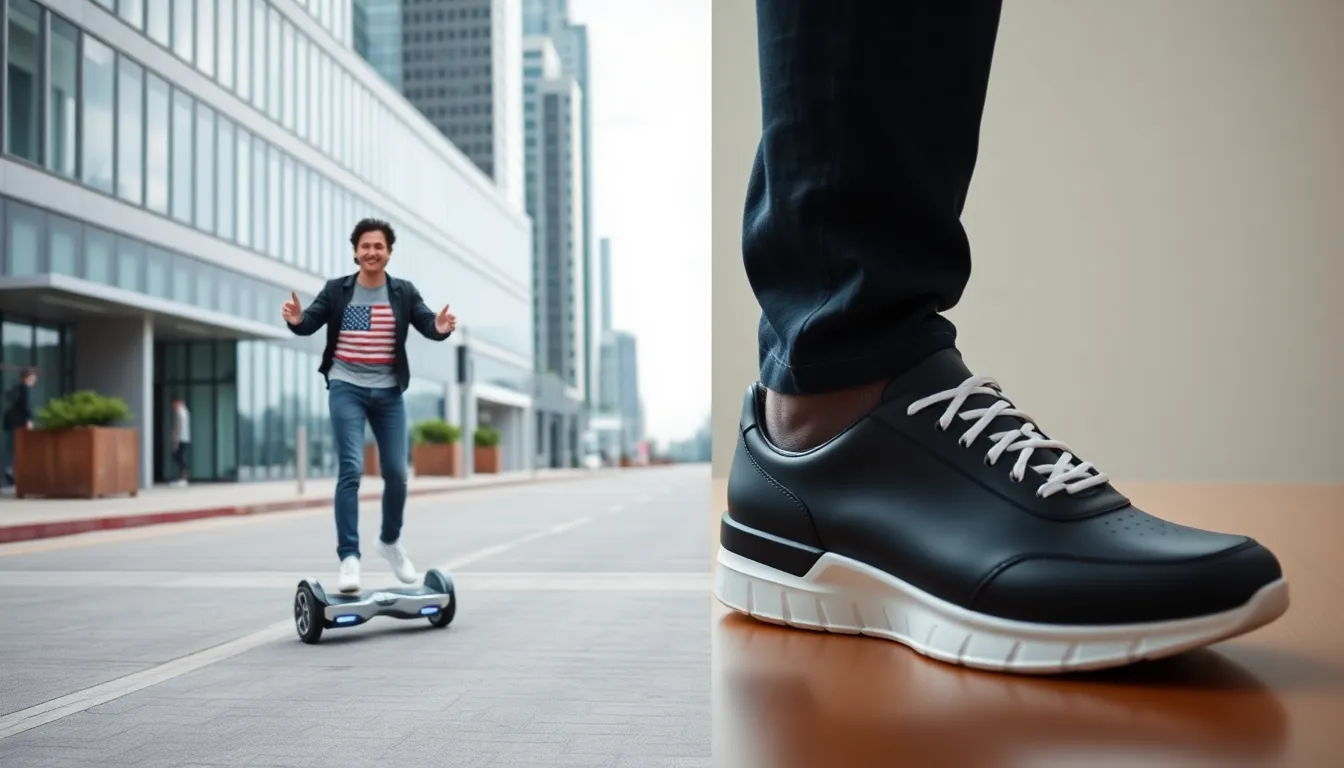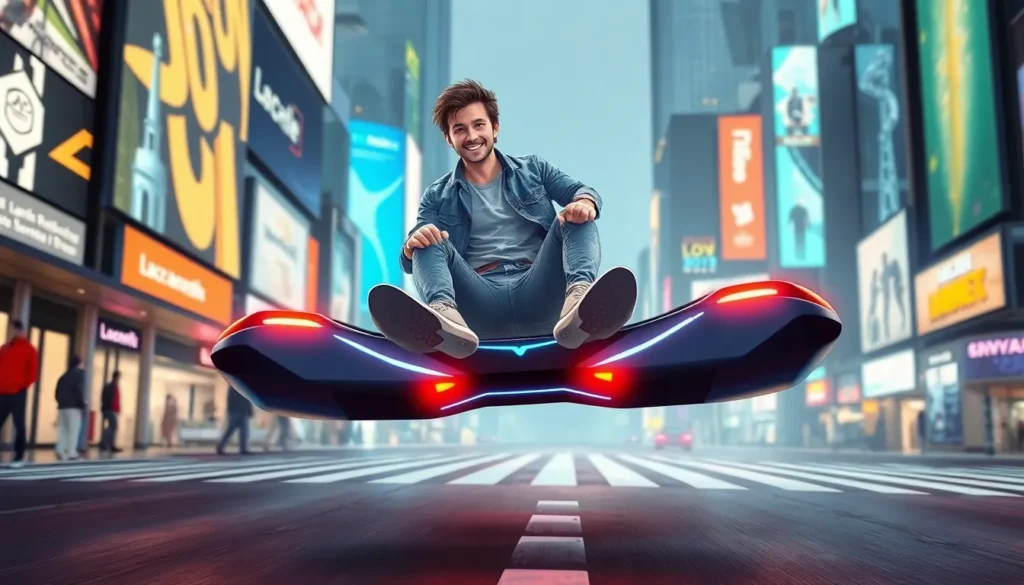Time travel might still be a dream, but the predictions from Back to the Future have become a fascinating lens through which to view our present. As Marty McFly and Doc Brown zipped through time, they offered a glimpse into a future filled with hoverboards, flying cars, and self-lacing sneakers. While we may not have all those gadgets yet, some of their whimsical predictions have surprisingly come true, making us wonder just how close we are to that iconic 2015.
Table of Contents
ToggleOverview of Back to the Future Predictions
“Back to the Future” presents several notable predictions about technological advancements and societal changes. These imaginative forecasts include hoverboards, flying cars, and self-lacing sneakers. Each invention showcases the film’s optimistic view of future innovation.
Hoverboards capture attention with their promised ability to glide above the ground. While real hoverboards have emerged, they differ from the film’s depiction, relying on specific technologies like magnets or wheels. Flying cars represent another ambitious vision. Some companies are developing prototypes, moving closer to a practical flying vehicle.
Self-lacing sneakers intrigued audiences, emphasizing automation in everyday products. Today, some brands, like Nike, offer self-lacing shoes, demonstrating the film’s influence on modern design. Additional predictions include video conferencing technology. This aspect became widely significant during the COVID-19 pandemic, with platforms like Zoom becoming integral to daily life.
Moreover, the film’s take on fashion, such as digital billboards and futuristic clothing, showcases evolving trends in marketing and consumer behavior. Smart homes and connected devices mirror the film’s portrayal of seamless technology integration into daily life.
Surprisingly, some of the whimsical predictions in “Back to the Future” align with actual advancements. While not all forecasts came true by 2015, they inspired technological curiosity and innovation in various fields. Each prediction serves as a reminder of the ongoing journey toward achieving a futuristic world.
Technological Predictions

“Back to the Future” made several predictions about technology that continue to captivate audiences today. These imaginative innovations have inspired real-world advancements, bridging fiction and reality.
Hoverboards and Their Current Status
Hoverboards, once a fantastical dream, have seen real-life adaptations. Various companies now produce hoverboard-like devices utilizing gyroscopic technology, allowing riders to glide above ground. While these products don’t completely replicate the film’s vision, they represent a significant step toward personal transportation innovation. Some models feature self-balancing mechanisms, enhancing safety and user experience. The fascination with hoverboarding demonstrates a growing interest in developing efficient mobility solutions. Further advancements may bring us even closer to true hovering technology in the future.
Self-Lacing Shoes and Innovations
Self-lacing shoes, a standout prediction, have transitioned from screen to reality. Nike introduced self-lacing versions, known as the Nike Adapt series, showcasing this innovative technology. These shoes employ a smart system, allowing users to adjust fit via a smartphone app. This feature enhances comfort and convenience, appealing to athletes and tech enthusiasts alike. Brands continuously explore integrating smart technology into footwear design, indicating a trend toward customization. As more advancements emerge, self-lacing shoes symbolize a blend of style and functionality in modern fashion.
Social Predictions
The film “Back to the Future” offered a unique glimpse into future societal norms, especially around family dynamics and fashion. These predictions resonate in modern contexts.
Family Dynamics and Relationships
In the film, family interactions displayed a blend of technology and intimacy. Parents engaged with their children through devices that fostered connection. This mirrors today’s reliance on smartphones and laptops for communication within families. Children and parents utilize technology to share experiences, bridging gaps created by busy schedules. Family gaming sessions and video calls have become commonplace, showcasing how digital tools enhance familial ties. Also evident is the importance of adaptability; families now navigate their dynamics through evolving technology, reflecting the film’s foresight regarding relationships.
Fashion Trends and Their Evolution
Fashion in “Back to the Future” demonstrated a speculative yet fascinating view of future clothing. The film highlighted vibrant outfits and futuristic materials reflecting personal expression and innovation. In recent years, fashion has embraced smart textiles and wearable tech. Brands now integrate features like health tracking into clothing, showcasing practicality alongside style. Digital displays and custom-fit options echo the ideas portrayed in the film. The rise of digital fashion shows and virtual fitting rooms signifies a shift towards online shopping, mirroring the film’s predictions about the fashion industry’s evolution.
Environmental Predictions
“Back to the Future” hinted at environmental challenges that resonate today. The film’s optimistic tone contrasts with the urgent reality of climate change awareness.
Climate Change Awareness
Awareness of climate change has surged since the film’s release. Advocates emphasize the importance of addressing rising temperatures, severe weather patterns, and habitat loss. Educational platforms now engage audiences through campaigns that highlight sustainability. Technologies promoting eco-friendly practices have gained traction, as seen with electric vehicles and energy-efficient appliances. Global initiatives aim to reduce carbon footprints and foster environmental stewardship. Engaging communities through social media amplifies messages and motivates action toward a healthier planet. Key organizations, like the United Nations, actively promote objectives centered on climate action. The need for collective responsibility resonates deeply, encouraging individuals and governments to unite in combating climate change.
Renewable Energy Advancements
Advancements in renewable energy reflect the film’s futuristic vision. Solar and wind energy have transformed energy production, driving down costs significantly over the last decade. Investments in battery storage technologies enhance the reliability of renewable sources, allowing for smoother transitions away from fossil fuels. Emerging concepts such as hydrogen fuel cells showcase potential for clean energy applications in transportation and industry. Countries globally set ambitious targets for net-zero emissions, aligning with the film’s foresight of a sustainable future. Innovations in energy efficiency continue to evolve, making systems smarter and more adaptive. These developments demonstrate a strong commitment to cultivating a greener economy and a healthier environment.
Cultural Impact of Back to the Future
“Back to the Future” reshaped cultural perceptions of technology and innovation. The film inspired generations to imagine future possibilities, particularly in personal transportation. Hoverboards, first seen in the film, prompted real-world exploration into similar technology. Companies have developed hoverboard-like devices utilizing gyroscopic technology, showcasing this lingering fascination.
Self-lacing sneakers also emerged as a cultural phenomenon. Nike’s Adapt series embodies the film’s innovative spirit, allowing users to adjust fit via smartphone apps, appealing to tech enthusiasts. Integrating smart technology into footwear symbolizes a blend of style and functionality in modern fashion.
With the rise of video conferencing during the COVID-19 pandemic, the film’s foresight became increasingly relevant. Platforms like Zoom emerged as essential communication tools. Fashion depicted in the film, which included digital billboards and futuristic clothing, continues to influence trends in marketing and consumer behavior.
Family dynamics showcased in “Back to the Future” resonate today. Family interactions in the film reflect contemporary reliance on smartphones and laptops for communication. This technology fosters connections through shared activities like gaming and video calls, illustrating modern adaptability.
Vibrant outfits and futuristic materials anticipated the rise of smart textiles. Contemporary brands now incorporate health tracking features and custom-fit options, echoing the film’s vision of personal expression. Digital fashion shows and virtual fitting rooms signify a shift toward online shopping.
Environmental themes presented in the film offer juxtaposition to today’s urgent climate challenges. Climate change awareness has surged since its release, prompting discussions on eco-friendly technologies. Electric vehicles and energy-efficient appliances represent progress, paired with initiatives aimed at reducing carbon footprints. Innovations in renewable energy, such as solar and wind, reinforce the film’s optimistic outlook for a sustainable future.
The predictions made in “Back to the Future” continue to resonate today, showcasing the film’s lasting impact on technology and culture. While some visions remain unfulfilled, the advancements in hoverboards, self-lacing sneakers, and smart home technology reflect a fascinating journey toward innovation.
As society grapples with climate change and seeks sustainable solutions, the film’s optimistic outlook serves as a reminder of what’s possible. Its influence on family dynamics and fashion trends highlights the evolving relationship between technology and everyday life.
Ultimately, the film inspires ongoing curiosity and exploration, encouraging a future where imagination and innovation go hand in hand.

